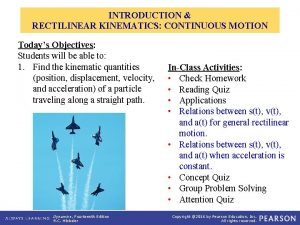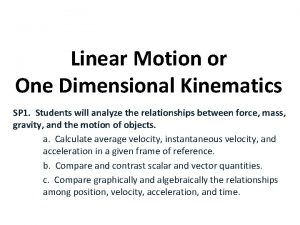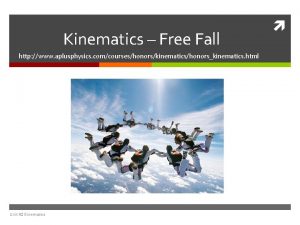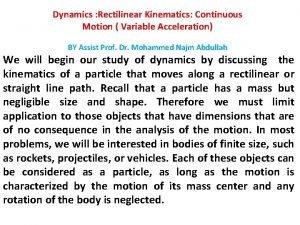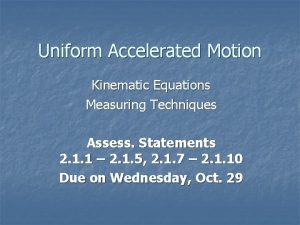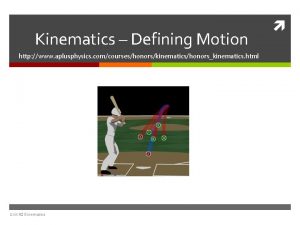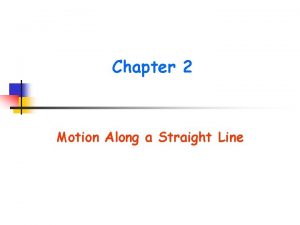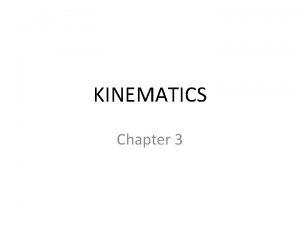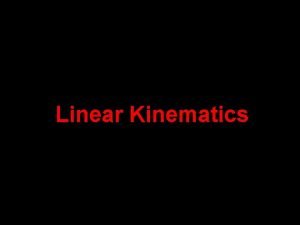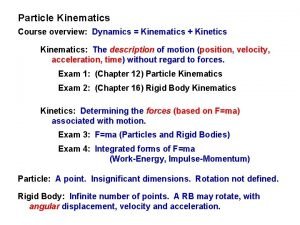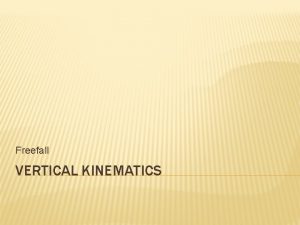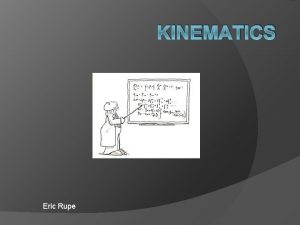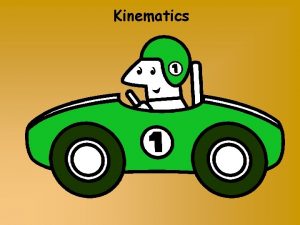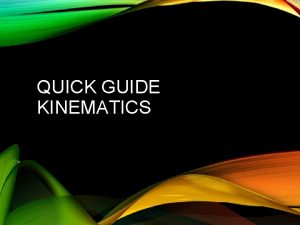Introduction to Kinematics The Study of Motion Kinematics











- Slides: 11

Introduction to Kinematics: The Study of Motion

Kinematics A quantity can be described as being vector or scalar. • Vector – a quantity that is represented by both magnitude (size) & direction • Scalar - a quantity that is represented by magnitude (size) only

Kinematics Position Versus Distance • Position – the separation between an object and a reference point • Distance – the separation between two points A reference point is a designated spot from which to measure

Kinematics • Instantaneous Position – the position of an object at one instant, at one single time. • A change in position is called displacement. • d = d 2 – d 1 where d is displacement, and d 2 and d 1 are positions • Distance – scalar; Displacement – vector, and can be positive or negative

Kinematics Average Velocity – the change in position divided by the difference in time _ d d 2 – d 1 v = t t 2 – t 1 Average Velocity can also be calculated if you know an initial velocity and a final velocity… v = vf + vi 2

Kinematics Finding Displacement: d =v t Substituting in the average velocity equation: v = vf + vi d = vf + vi t 2 2 OR…. . d = ½ (vf + vi ) t

Kinematics Positive & Negative Velocities • Similar to positions and displacement, velocity can be described as being positive or negative, depending on the direction the object or body is moving. • If the direction of the body is positive, velocity is positive • Because of this, we use the terms speed for how fast an object is going & velocity for the speed and its direction

Kinematics Position-Time Graphs • A graph that shows how position depends on time • The slope is change in position (displacement) divided by time = velocity • A linear, direct relationship = constant velocity • A parabolic, direct relationship = acceleration (speeding up)

Kinematics Position – Time Graphs (cont. ) • When an object is accelerating, you can find the instantaneous velocity by using a tangent line, then calculating the slope of the tangent line

Kinematics Acceleration • Acceleration is the rate at which velocity changes • Average acceleration – the ratio of change in velocity to a change in time a = v 2 – v 1 = v t t

Kinematics • Acceleration is a vector quantity • It can be positive or negative • Positive acceleration – the velocity is increasing • Negative acceleration – the velocity is decreasing ****later, we will go further in our discussion of positive & negative accelerations…
 Aplusphysics kinematics-horizontal kinematics
Aplusphysics kinematics-horizontal kinematics Distinguish between time study and motion study
Distinguish between time study and motion study Difference between time study and motion study
Difference between time study and motion study Rectilinear kinematics
Rectilinear kinematics Rectilinear kinematics
Rectilinear kinematics 1 dimensional kinematics
1 dimensional kinematics Galileo trick kinematics
Galileo trick kinematics Rectilinear motion with variable acceleration
Rectilinear motion with variable acceleration Rearranging kinematic equations
Rearranging kinematic equations Kinematics of simple harmonic motion
Kinematics of simple harmonic motion Aplusphysics kinematics-free fall answers
Aplusphysics kinematics-free fall answers Motion along a straight line definition
Motion along a straight line definition



